FLYING TIGERS CHENNAULT TO HEAD CHINA AIR FORCE
Washington, D.C. • July 4, 1942
On this date in 1942 Gen. Claire Lee Chennault was appointed commander of China Air Task Force (CATF), replacing his original (officially disbanded) command, the American Volunteer Group (AVG) of “Flying Tigers” fame. The AVG volunteer group of U.S. Army, Navy, and Marine flyers had been created by Nationalist Chinese leader Generalissimo Chiang Kai-shek and sanctioned by President Franklin D. Roosevelt prior to the entry of the U.S. into World War II. In 1942 the three AVG Flying Tigers squadrons were absorbed into the U.S. Army 23rd Fighter Group (a component of the CATF), which in turn was absorbed into the U.S. Fourteenth Air Force, with Gen. Chennault as commander and his fighter aircraft retaining the distinctive shark’s mouth nose art of the initial volunteer unit.
The core group of 99 AVG volunteers first saw combat in China on December 20, 1941, twelve days after Pearl Harbor, when an AVG squadron engaged 10 Japanese Kawasaki Ki‑48s based in Hanoi, French Indochina, shooting down four and probably more of the twin-engine light “Lily” bombers at the cost of one of theirs, which crash-landed when the plane ran out of fuel. It was the first Allied victory of the Pacific War. By the end of the war Chennault’s pilots in the Fourteenth Air Force had attained air superiority over China’s skies and established a ratio of 7.7 enemy aircraft destroyed for every U.S. plane lost in combat. The Fourteenth Air Force is officially credited with the destruction of 2,315 enemy planes, 1,225 locomotives, 712 railroad cars, and 356 bridges.
Chennault’s innovative “dive-and-bomb” combat tactics, combined with the V12 single-engine Curtiss P‑40 Warhawk’s heavy armament (six Browning machine guns and up to 2,000 lb of bombs), pilot armor, self-sealing fuel tanks, and sturdy all-metal construction, contributed to the Flying Tigers’ distinguished service in Burma and China.
The P-40 was the third most-produced U.S. fighter (13,738 were built) after the North American P‑51 Mustang (15,000-plus) and the Republic P‑47 Thunderbolt (15,660). The iconic shark’s mouth on the nose of Chennault’s P‑40s remains among the most recognizable of any individual combat aircraft of World War II. U.S. airmen and the media continued to use the “Flying Tigers” name to refer to U.S. Army Air Forces (USAAF) units in China to the end of the war.
![]()
Gen. Claire Lee Chennault and His Flying Tigers, 1941–1945
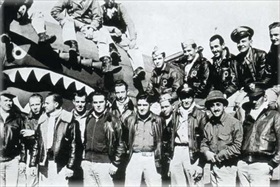 | 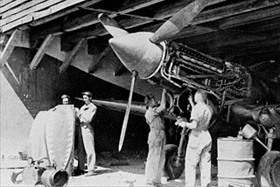 |
Left: The American Volunteer Group initially trained at a remote RAF base at Taungoo in Central Burma (today’s Myanmar) with the mission of defending beleaguered China against invading Japanese forces. AVG pilots like these shown in this February 1943 photo were recruited under presidential authority from the U.S. armed services. Ground crew and headquarters staff were likewise mostly recruited from the U.S. military, along with some civilians.
![]()
Right: A ground crew services a P-40 Warhawk of the 23rd Fighter Group at an airfield in China, 1942. P‑40 Warhawks came off a Curtiss-Wright assembly line in Buffalo, New York, which produced P‑40 Tomahawk IIB models for British Commonwealth squadrons in North Africa and the Middle East. An RAF squadron was the first Allied military aviation unit to feature the sharksmouth warpaint, copying similar markings on the noses of some Luftwaffe Messerschmitt Bf 110 twin-engine fighters.
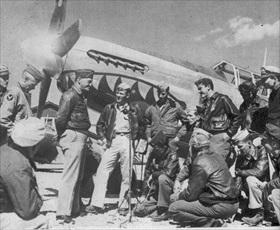 | 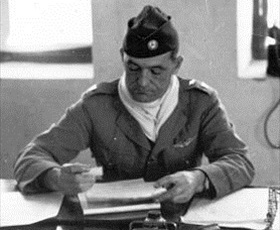 |
Left: In this 1942 photo Chennault (hands behind his back) converses with pilots of the 23rd Fighter Group. In the background is a P‑40 Warhawk, the group’s workhorse, bearing the distinctive sharksmouth nose art from AVG days. Incidentally, one of Chennault’s ace airmen, James H. Howard (six Japanese kills), was the only fighter pilot over Europe to be awarded the Medal of Honor, the U.S. military’s highest decoration.
![]()
Right: Claire Chennault was a 44-year-old retired U.S. Army Air Corps officer and former Army stunt pilot when he arrived in China in 1937 looking to start life over. He eventually became director of a Chinese Air Force flight school centered in Kunming, Southwest China, before being appointed commander of China Air Task Force. In this May 1942 photo, he wears a U.S. Army brigadier general’s star on his left shoulder but Chinese insignia otherwise. On March 10, 1943, Chennault was promoted to major general.
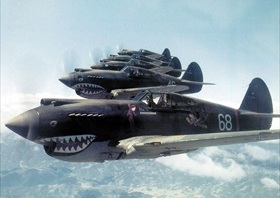 | 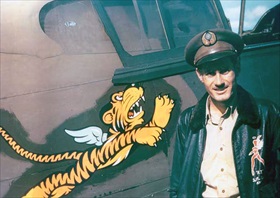 |
Left: Flying Tigers’ Third Pursuit Squadron, called “Hell’s Angels,” photographed near the Salween River Gorge on the Chinese-Burmese border, May 28, 1942. Flight Leader Robert “R. T.” Smith commented on the challenge of taking this photo while flying in formation and “scanning the surrounding sky every few seconds to make sure no Jap fighters were about to ambush us.”
![]()
Right: AVG squadron Flight Leader Robert “R. T.” Smith standing next to his P-40 Warhawk fighter, Kunming, China, May 23, 1942. Note Smith’s Nationalist Chinese emblem on his cap and the “Flying Tigers” insignia on his aircraft. The insignia was created by the Walt Disney Company.
1943 Documentary: Gen. Claire Chennault and the Fourteenth Air Force
![]()

 History buffs, there is good news! The Daily Chronicles of World War II is now available as an ebook for $4.99 on Amazon.com. Containing a year’s worth of dated entries from this website, the ebook brings the story of this tumultuous era to life in a compelling, authoritative, and succinct manner. Featuring inventive navigation aids, the ebook enables readers to instantly move forward or backward by month and date to different dated entries. Simple and elegant! Click
History buffs, there is good news! The Daily Chronicles of World War II is now available as an ebook for $4.99 on Amazon.com. Containing a year’s worth of dated entries from this website, the ebook brings the story of this tumultuous era to life in a compelling, authoritative, and succinct manner. Featuring inventive navigation aids, the ebook enables readers to instantly move forward or backward by month and date to different dated entries. Simple and elegant! Click 











